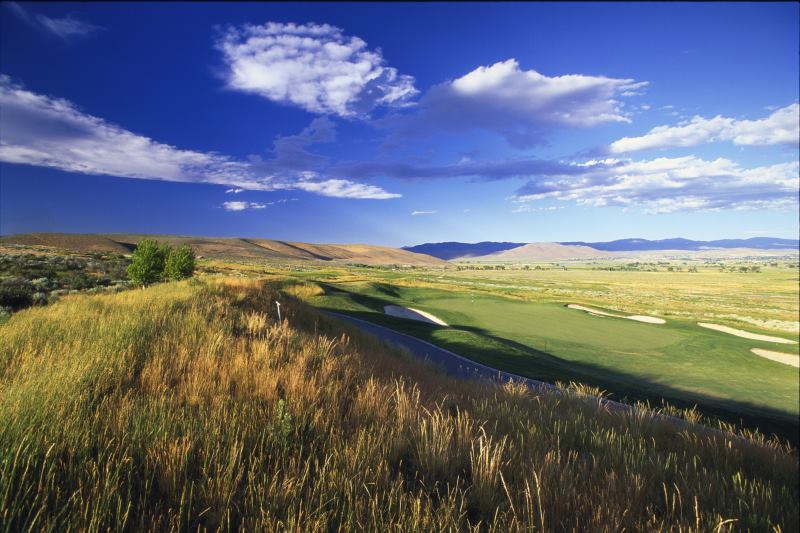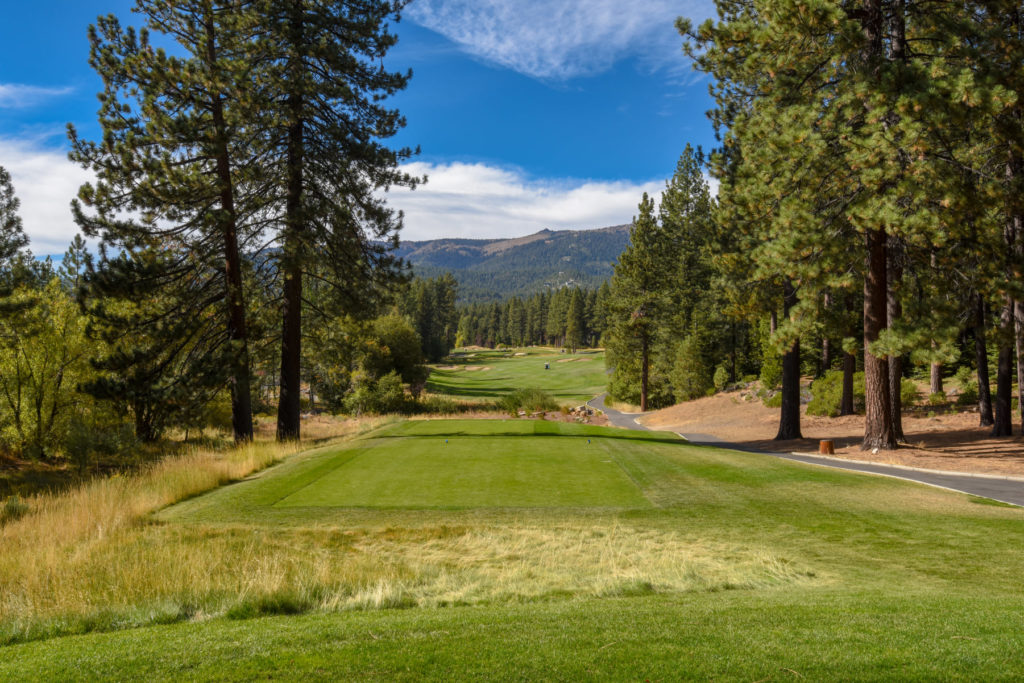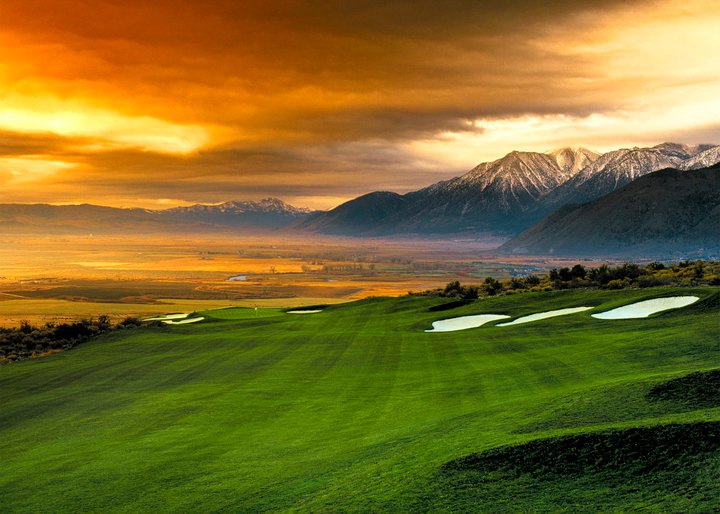
Lake Tahoe is, without a doubt, one of the most enchanting and gorgeous destinations in the United States. Its pristine, mountain-fed waters are kept that way by regulation, conservation efforts, and the lovers of the mountains ringing the lake.
Golf in the area is, as one would expect, equally picturesque. The courses here employ the Sierra Nevada mountains and the lake as backdrops that both enhance the golf experience. The surroundings here are all about yin and yang, setting a lofty bar for the courses in the region to measure up to.
In the case of Incline Village Golf Club’s Championship course, which is set at more than 6,500 feet above sea level, and Edgewood Tahoe, with two holes hugging the banks of the big lake’s southern edge, the courses are as iconic as their environs.
Then there’s the Lakes course at Genoa Lakes in the valley between the lake and Reno to the northeast which can either whet the whistle on the way up the pass or act as a great wrap up course to a trip to the region.
Perhaps the best compliment one can give to these three courses is that all live up to their spectacular setting.

Up and down at Incline Village
The Championship course at Incline Village, situated about halfway between Reno and Stateline, Nevada on Lake Tahoe’s northern banks, was originally designed by Robert Trent Jones Sr. and opened in 1964. It, like so many of the courses of Jones that bear his mantra of “tough par, easy bogey,” has always been a combination of beautiful vistas and demanding golf.
Nearly 20 years ago the Championship course (one of two tracks at Incline Village) received a $5 million facelift by Sacramento-based golf course architect, Kyle Phillips. The freshening added new life to the course, granted players some new risk-reward opportunities over trees and bunkers, while placing a premium on accuracy and the short game.
Phillips’ renovation restored several of Jones’ original design characteristics and updated the course’s playability to provide a true test of golf with today’s technology. The Championship course’s short par-5s are now more challenging, with features like elevated, well-bunkered greens – some of which were reduced in size and/or shifted closer to hazards.
Jones designed the Championship course on property a mile from the lake. It drew water from two creeks, and he involved those creeks to make players think about strategy. The actual building of the course was arduous, as the back nine was routed through a field of boulder-strewn granite. More than six feet of fill was brought in to cover the rock, but the hard subsurface continues to present problems for the drainage and irrigation systems.
The Championship course is a par-72 and carded at 7,106 yards from its back set of five tees. The longest par-4 is just 437 yards, and only three of the two-shotters exceed 430 yards, an indication that Jones expected players to golf their ball with some forethought.
The fairways on the Championship course are pine tree-lined and unusually generous for a mountain course, tightened only on the few occasions when the landing areas are pinched by bunkers. The front half climbs to higher elevations for better views of the lake, while the meandering creek is most prominent on the home half, where seven of the nine holes have water in play, usually near the greens.
The 514-yard par-5 second is the initial risk-reward hole. The dogleg-left moves around a complex of bunkers that are very difficult to carry from the tee. Staying just right of them, however, allows for a good shot at flying another bunker 30 yards short of the green.
The 203-yard sixth ranks as one of the most difficult par-3s anywhere. It plays slightly downhill to a green with no bailout short; a deep creek cuts right in front of the putting surface. Anything right or long will catch a bunker or deep rough. The green tilts radically as well.
The back nine is the cat’s meow, with its first real challenge coming at the 494-yard 11th. This short but wonderful par-5 is all about the approach; either clear the creek with a long-iron or fairway wood or layup.
At 437 yards, the 15th is the longest par-4 on the course. From its slightly elevated tee the player will need to shape a shot to avoid bunkers and the creek crossing the fairway. The second is to a putting surface that slopes sharply right to left, with bunkers on both sides narrowing the focus.
The 175-yard 17th is the shortest par-3 on the Championship course, with a tee shot through an incredibly tight chute of trees. There’s also a large bunker short-right of the green, and anything long will end up in a hazard aft.
The round at Incline Village’s Championship course ends with an uphill, dogleg-left 413-yard par-4 that may be the course’s toughest test. On the right side of the landing area is a series of small ponds that extend up to the edge of the green while adding to the equation is a large bunker short-right.
Incline Village was created in the 1960s as a vacation-home community and has only grown in popularity over the decades. Residents enjoy the use of two beaches on the lake, a recreation center as well as the two golf courses.

Edgewood Tahoe’s best holes are away from the lake
Anyone who follows golf is familiar with Edgewood Tahoe Golf Course, the site of the PGA Tour’s annual American Century Celebrity Golf Championship. Most of the broadcast of the event centers on shots of celebrities – many of them very good golfers – and of boats bobbing in the gleaming lake alongside the 17th and 18th holes.
Located on the Nevada side of the California-Nevada border in Stateline, Edgewood Tahoe is the only course along the shores of Lake Tahoe. It was designed by George Fazio in 1968 and was updated and renovated in the late 1990s by his famous nephew Tom. Positioned just up the lake from the South Shore’s casinos and hotels, its setting in a lush meadow is memorable, with the Sierras so close it seems they can be touched.
Edgewood Tahoe has hosted a variety of major golf events, including the U.S. Public Links in 1980 (the first USGA event ever held in Nevada) and the U.S. Senior Open in 1985, when Miller Barber captured the title as the only player in the field to break par on the demanding layout. And there’s the Celebrity Golf Championship featured on NBC; the 2022 event will be held July 6-10.
There’s more to this course than the show it puts on for television. Edgewood Tahoe is more playable than punitive and asks players to hit a variety of shots (especially left-to-right) and have perseverance and skill on and around the greens.
The par-72 itself can be quite a bear, especially when played from the tips at 7,529 yards. But there are three other sets of tees to make the course playable for all skills.
Early on, players get tested with the first par-5, the 599-yard third. The fairway is wide, with the adventurous given the option of flying a large bunker at the corner. The second shot must be played right of a water hazard and either short or past cross-bunkers. Positioning here is crucial as the uphill approach must be hit from a good angle to find a well-bunkered green.
The 472-yard par-4 sixth heads downhill to a broad fairway that narrows quickly for those hitting driver. Being aggressive is rewarded, however, as the approach plays over a lake that laps the front of the green. This putting surface, surrounded by sand, is deep and bears a lot of contour.
Edgewood Tahoe’s 466-yard par-4 eighth is one of two holes (along with the 16th) with a lone tree in mid-fairway. A shot on either side of it sets up an ideal second.
The 214-yard par-3 12th descends to a shallow, steeply pitched green. The real attention- and ball-grabber here is a large bunker front-right with a tall pine.
The 14th, a 434-yard par-4, embodies all that’s great about Edgewood Tahoe. After a drive through a piney alleyway, the hole turns right to present a wide-open view of the green, with Lake Tahoe and Mt. Tallac directly behind it. This is a strikingly beautiful hole.
Edgewood Tahoe impresses with its last few holes, with the lake in a starring role after supporting the cast through the first 16. No. 17 (a 207-yard par-3) is hard by the lakeshore and buffeted by winds off the water. While the focus is on the beach at the starboard side, a tall pine front-left of the green also influences play.
The finisher is a 572-yard par-5, whose fairway is sandwiched between a smaller lake left and the much larger Lake Tahoe right. The super-fine Edgewood Tahoe clubhouse rests behind the green. Because the golf here is so good, players may be less inclined to imbibe a few than drive straight to the golf shop and check if there’s a chance for a replay round.
Edgewood Tahoe Golf Club is meticulously maintained and arguably one of the most scenic golf courses in the world. It’s rated by Golf Digest as one of “America’s Top Golf Courses.”

Lakes course at Genoa Lakes is defined by water
Genoa is the oldest established town in Nevada. Originally called Mormon Station, it began as a supply town for early settlers in 1851. Situated 18 miles from Lake Tahoe and accessed by driving over a high and scenic mountain pass, Genoa remains a little burg in the middle of a fertile plain amid the Sierra Nevadas.
Genoa is also the home of two golf courses – the Lakes and the Resort – that serve as centerpieces for neighborhoods attracting retirees and second-home owners to the Carson Valley. Both courses were designed by former PGA Tour pro Peter Jacobsen and the late golf architect John Harbottle III.
We were lucky enough to play the Lakes, which opened in 1994. Soon after its debut it was ranked by Golf Digest as among the best new public courses in America. It’s a combination of demanding shot values in an unhurried, panoramic setting, its routing defined by water hazards that are in play on 13 holes.
The layout also features heaving fairways that are bordered by well-placed bunkers. This is a golf course that calls for long, straight drives.
Harbottle worked as an associate of Pete Dye for a decade before branching out on his own, and Dye’s influence can be seen in the Lakes’ steep-faced bunkers and a premium placed on accuracy. Harbottle, who died at age 53 at the prime of his career, went one better than the master on many of the holes, adding bailout areas to nearly every greens complex to give options for players of different skills.
Harbottle’s thoughtful strategies are seen on many holes, some of which have water situated 100 yards off the tee, while others have forced carries requiring a drive twice that distance.
The Lakes is a par-72 and is 7,359 yards from the tips. Although it plays shorter than the yardage because the property is at an elevation of 4,800 feet, it’s best to judge your game than rely on the thin-air altitude to help propel balls across the track’s lakes, willows, and wetlands.
Throughout the opening nine, the eastern slope of the Sierras – dominated by massive Freel Peak – is on view from every hole. The course’s twists and turns, offering vistas in every direction. The home half is quite different as the Carson River crosses the back nine five times.
Great golf courses have stout finishing holes and Lakes satisfy that criterion. The 414-yard, par-4 16th involves a carry over wetlands off the tee, while a lake along the left protects the severely tilted 16th green.
The 541-yard, par-5 17th demands a good drive and solid approach as its massive green sweeps to the right and is engorged along the right by a series of deep bunkers; there’s a bailout area to the left. The 449-yard par-4 closer features a drive over a huge lake, which guards the left side of the fairway all the way to a wavy green.
All in all, the Lakes course has a little bit of parkland flavor and a touch of the links, all set in in the valley surrounded by Nevada’s mountains. Landing areas are generally wide, although some of the sightlines off the tees can be deceiving.
Genoa Lakes is a place that exudes charm and class throughout and is a solid companion to Edgewood Tahoe and Incline Village on the way into or out of the Lake Tahoe area.

